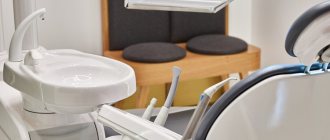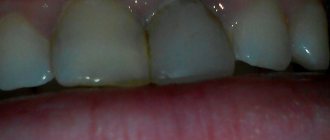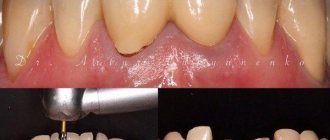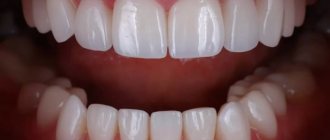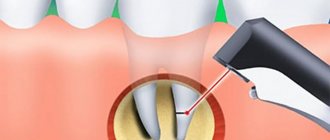Causes of dental injuries
Damage to baby teeth can be caused by any strong force applied to the jaw. For example, if a child was running and accidentally fell with his cheek on some object (chair, curb, step), this may well lead to a bruise or fracture of a tooth. Acute injuries also occur from blows to the face when children fight or play sports like boxing and karate.
Based on the nature of the acquisition, the reasons are divided into household, sports and travel. They are sudden and very painful. There are also chronic injuries that occur due to long-term bad habits. Biting nails, felt-tip pens, ballpoint pens, threads while sewing, or cutlery thins the enamel. Thin, fragile enamel and caries of baby teeth become the main factors of toothache in a child.
Symptoms of a tooth bruise
Immediately after an injury, an appointment with pediatric dentistry is required. Often parents bring their children after a week or a week and a half. This makes examination and treatment of lesions difficult. In the first hours after damage to the masticatory organ:
- Children feel pain.
- Pain increases when biting on a pathological unit.
- The gums swell, redden, and become dense.
- If, as a result of a bruise, a vascular bundle ruptures, blood appears, and pulpal hemorrhage may develop.
- The baby's condition worsens, he becomes restless and whiny.
- The temperature may rise. The child loses his appetite.
Only a doctor can help in such a situation. If a child’s baby tooth darkens after an impact, the blood vessels and pulp tissues could be damaged. In most cases, such processes are reversible. You should take your child to the doctor if there are signs of a bruise. Without treatment, the structure of the abnormal units will suffer, which will negatively impact dental health. The symptoms of severe damage are easy to recognize. In addition to painful sensations, pinkish enamel is clearly visible due to rupture of blood vessels. Brown spots appear after trauma to the periodontal tissues that hold the unit.
In dentistry, the following types are distinguished:
- Bruised tooth. It can be considered the mildest type of injury, which is provoked by blows, attempts to bite through a hard object or “taste” it, which is especially typical for children 1-3 years old.
- Tooth dislocation. Such an injury means that the tooth has moved from its usual place. Typically, this type of injury requires significant force, so it does not occur as often as bruises. There are cases of complete dislocation, when the entire tooth falls out of the socket. Modern pediatric dentistry can save even a lost tooth if there are favorable conditions for this, and parents brought their child in immediately after receiving an injury.
- Tooth fracture. Fractures are immediately visible - these are visible chippings of a corner, piece or most of a baby tooth. Most children break their front teeth; the most popular causes of such damage include fights.
- Fracture of the root or crown of a tooth. They are considered rarer species, because in normal everyday life and sports conditions it is extremely difficult to get such a deep fracture. Regardless of whether the child has acquired a simple tooth bruise or suffered a fracture, in any case it must be shown to a specialist so as not to endanger the health of the young body.
Trauma to the mouth and teeth. What to do and where to run?
Authors : Solovyov D.V.
Injuries, especially in the facial area, scare people perhaps the most. And yet, with an adequate reaction, most often nothing terrible happens. So let's talk about what and how to do in such a situation. Do it for both adults and children. The main thing right away: due to the abundance of facial muscles and good blood supply, wounds on the face and mouth often seem much larger and more serious than they actually are. Therefore, in any situation, remain calm! Screams and hysterics will not change anything; only quick and cool-blooded actions can help!
A blow with the teeth or on the teeth. When to see a doctor urgently (at least one of the following):
- something red is visible in the tooth;
- there is severe pain;
- the tooth appears to be loose;
- the tooth apparently changed its position;
- the tooth does not hurt or become loose, but over time it began to change its color, at least slightly.
Chip of a piece of tooth.
- The chip is small, does not interfere or bother you in any way: you don’t have to do anything.
- If the edge is sharp or looks unsightly: in baby teeth it can be polished (by a doctor), in permanent teeth it can be restored with a filling or veneer.
- Large chip: restoration with a filling or veneer. At the same time, be prepared for the fact that you may have to fill the canals (this is done when the nerve of the tooth is damaged).
The tooth is loose.
- At home before the doctor: do not bite on the tooth.
- Baby tooth: it all depends on how much time is left before eruption. A little - we delete and forget, a lot - perhaps it will still serve.
- Permanent tooth: Initially, an image is taken to assess whether there is a root fracture. If, unfortunately, there is only removal, if the root is fractured, there are no methods that can heal it and prevent further inflammatory process, so sometimes the advice to wait for something is meaningless! The faster you remove it, the fewer problems there will be. If there is no fracture, the tooth is temporarily splinted (“glued”) to the adjacent teeth.
The tooth is rotated or impacted.
- At home to the doctor: do not turn back on your own!
- Baby tooth: with minor displacements, they often do nothing, because in many cases the tooth gradually takes the desired position on its own. If the displacement is serious and especially if it is impacted (the tooth has become “lower” than its neighbors), then it is undesirable to leave it this way - damage to the permanent tooth may occur.
- The tooth is permanent: there are techniques that allow you to return even a strongly displaced tooth to its place.
Which one will be used specifically in this case depends on the qualifications of the doctor, the technical equipment of the clinic and the financial capabilities of the patient. However, in any variant, it is first assessed whether there is damage to the neurovascular bundle (the “nerve” inside). If there is, then it will be necessary to treat and seal the canals. Subsequently, the tooth is returned to its place and splinted. It is impossible to determine the period of splinting in advance, but in any case, we are not talking about days, but about at least weeks and months.
The tooth fell out. Theoretically, there are methods for bringing back permanent teeth, but in practice this is difficult to achieve, so it is not done in real life.
The tooth has changed color over time. This suggests that there is something wrong with the “nerve” of the tooth. See a doctor as quickly as possible, because the situation may end in a purulent process! The ability to return a tooth to its original color depends on the stage of neglect and what kind of tooth it is (in the front teeth it is usually easier to do this, but the smallest shades of color are much more noticeable).
A cut of the skin or lip with bleeding. Don't be afraid of the amount of blood or the visible strong separation of the edges of the wound! This happens very often on the face due to the characteristics of the facial muscles and does not necessarily lead to noticeable consequences in the future. The main task is to stop the bleeding, so the first and most urgent action is to simply clamp the wound. You can do it with your hand, but it’s better with some piece of cloth. Why? Because, firstly, your hands will quickly slip, and secondly, with serious bleeding, you essentially chain yourself to the victim, without even being able to call for help. (We deliberately do not consider here methods of stopping bleeding on the limbs and other parts of the body; there are separate articles for this.) If you are on the street, the bleeding is heavy, and there is nothing clean at hand, do not be afraid to cover the wound with a dirty bandage. Dirt may get inside, or maybe not; even if you get it, the infection may or may not develop, but if you don’t stop it as quickly as possible in case of severe bleeding, the person will die right here and now, simply before the infection develops. - Apply a pressure bandage. First, we apply a rectangle of fabric folded in several layers (“pillow”), then either tie it with a bandage around the head (as best we can, specialists will do this more professionally later), or stick on an adhesive plaster. You can apply cold on top of the bandage, but for no more than 20-30 minutes; there is no need to apply ice for half a day. (If there is time and opportunity, it is better to repeat the application of the cold one for another 10-15 minutes every 2 hours.) If there is a protruding foreign body in the wound (precisely protruding, and not lying on top), it is absolutely forbidden to pull it out! Do not forget that after stopping the bleeding, any wound must be washed. If we are at home, we rinse with saline solution or just a stream of tap water, then pour a soap solution into a bottle (liquid soap or scrape out a little solid soap with a potato peeler) and pour it over the wound. We finish again with clean water. We are in nature and there is no clean water - we take any (including from a lake, river, etc.). The point is that the dirt already in the wound is much more dangerous than what is in the water of even an ordinary lake. Therefore, you must choose the lesser of two evils: if there is no clean water, wash it with what you have. It is strictly forbidden to pour iodine or brilliant green onto a wound! This is one of the most serious everyday misconceptions, because once these substances get into a wound, they seriously slow down its healing. The maximum that can be done is to treat the wound edges, but nothing more! After washing the wound, cover it again with a bandage or adhesive plaster (make sure that the sticky edges of the plaster do not stick to the wound itself). Any damage to the facial skin requires examination by a doctor as quickly as possible (within 6 hours)! Inspection is especially important if the wound is a bite wound! However, don't worry too much, modern cosmetic surgery can do a lot even in cases of really serious injuries. Do not forget also that any damage to the skin requires a tetanus vaccination (especially if more than 10 years have passed since the previous one).
Biting the cheek or tongue. Despite the often severe pain, it usually goes away completely on its own. Close attention is required only when biting off a large area of the cheek or tongue, when the wound may need to be stitched. A special case is completely biting off a piece of the tongue. We put the bite in an ice pack and go to the hospital. Yes, they sew it on. You can alleviate the condition by putting something cold in your mouth, even just ice cream or a piece of ice (just remember that if the child is small, you should not give him any small pieces). Separately, we need to dwell on the much-loved “washing with potassium permanganate.” In short, you don’t need to rinse anything with it, especially in your mouth! The bottom line is that the standard dilution of potassium permanganate is 10 g per liter of water. Dilute this amount somehow just for fun, and you will see that it is a very dark “tea”. The minimum dilution at which at least some disinfectant effect is observed is at least 1 g per liter. Those. all this has absolutely nothing to do with that pale pink solvent, made from one or two crystals, and which is used most often. It doesn't disinfect anything! Actually, in such procedures “to calm one’s own thirst for activity,” there would be nothing terrible if it were not for the ability of permanganate crystals (i.e., that same potassium permanganate) to lead to severe burns if they suddenly accidentally fall in an undissolved state on the mucous membrane (thus more, being accidentally swallowed). If you gape, an almost imperceptible crystal will bounce off even just onto the edge of a cup - you will get a terrible problem. Therefore, it’s better not to, it’s not worth it.
See a doctor immediately if:
- blood flows in a stream;
- the bleeding does not stop within half an hour;
- general health worsens;
- the temperature has risen;
- the pain does not decrease over time (or even worse increases);
- the tumor continues to grow;
- numbness appeared;
- There is any symptom that you do not understand.
Injury. Actions:
- a pressure bandage for at least 10-15 minutes (if it is not possible to tie it on, just hold it with your hand; in extreme cases, pressing with your fist will do);
- cold on the site of the injury (necessarily through a cloth) - for about half an hour. Ideally repeat every couple of hours for 10 minutes.
It is forbidden:
- Warm up earlier than after about a couple of days.
- Accordingly, a variety of “warming” ointments.
- Rub the bruised area.
The point is that immediately after a bruise we must stop the bleeding (which is inside) and the spread of swelling, for this we need cold and pressure. Warming and rubbing at this time only promotes further bleeding and inflammation. After a couple of days, everything changes - the bleeding has stopped long ago, resorption therapy is needed, which is what heat does.
Remember that identifying a fracture is sometimes not so easy, so if in doubt, consult a full-time doctor at the first opportunity. Immediately consult a doctor if you have the same symptoms as described in the previous paragraph about cheek bite.
Jaw fracture. You can suspect if there is:
- Unnatural jaw position.
- Sharp pain when trying to move it.
- Inability to fully close the teeth or a feeling of a changed bite.
- During the injury, a crunching sound was heard.
- Rapid swelling or rapidly spreading bluishness at the site of injury.
There is only one action: see a doctor immediately! At home before the doctor: if possible, do not move your jaw, do not try to squeeze it in the “correct” position. What the doctor will do depends on the severity of the injury and where exactly the fracture is located. But in any case, an X-ray examination and at least splinting of the jaws are carried out. Splinting in this case is essentially tying the jaws together in a special way (in the mouth, through the teeth). Whether any additional surgery or removal of some teeth is needed is decided depending on the situation.
For any head injury, see a doctor immediately if:
- The swelling continues to worsen.
- Redness appears that was not there, or the one that was there increases.
- The skin over the injury site became hot.
- The general condition worsens (temperature rises, poor health increases).
- Bruises have appeared under the eyes or behind the ears.
- There was even a short-term loss of consciousness.
- Vomit.
- Loss of coordination or speech.
- Discharge of any fluid from the nose and ears (for example, immediately after an injury a runny nose appeared that was not there before).
- Unusual sleepiness or unusual behavior.
- Cramps.
- Pupils of different sizes.
- Within two days there was absolutely no improvement.
- Any symptom that you do not understand.
I hope that what is written here will never be useful to you. However, a person still cannot survive without injuries, and therefore it is better to be prepared for this in advance.
But the choice, as always, is yours. 
Consultations by Dmitry Solovyov at ClubCom
published 05/02/2014 16:50 updated 27/09/2016 — Diseases of the teeth and oral cavity, Dentistry
IF A CHILD KNOWS OUT A MILK TOOTH
- Due to the small age of the child, additional technical difficulties immediately arise, therefore, the knocked out tooth, if it has fallen out, should be placed immediately in cow’s milk.
- You need to get to the dentist within 30 minutes.
- There is a possibility that the dentist will refuse to replant a baby tooth, citing the patient’s young age and a change of teeth in the near future, that is, the inappropriateness of the procedure. But baby teeth are also subject to replantation, remember this. If you're lucky, the dentist will turn out to be sane and believes in miracles, and the tooth will be a vigorous, lively person; the child will implant the tooth. Need to try.
The dentist will do additional fixation, prescribe physical procedures, the tooth will take root - that’s elementary.
The statistics for permanent teeth are as follows:
If the tooth is returned to its place within 30 minutes, it will take root in 90 percent of cases; if replantation is delayed for up to 2 hours, it will fail in 90 percent of cases. It is clear that during the first 30 minutes, first aid to the injured child will be provided by his parents. According to Polish researchers, the percentage of medical workers willing to replant a tooth at the site of injury is only 7 percent; the rest prefer to call parents to take the child to the dentist. And this is a waste of time, reducing the chance of engraftment.
Therefore, forewarned means forearmed. Tell your friends.
IF A CHILD HAS KNOCKED OUT A PERMANENT TOOTH
- The tooth must be found, lifted from the ground, rinsed under cool running water for 10 seconds, holding it by the crown - do not rub or touch the root.
- Insert into place as soon as possible. Don’t be embarrassed that if it protrudes a little, the dentist will correct it as needed. Bite on a handkerchief for better fixation of the tooth.
- If a child or parent is afraid to put the tooth in its place themselves, place the tooth in cow's milk, saline (BUT NOT WATER!!!!) (they also recommend placing the tooth in the mouth of an older child, but how realistic is this - it seems to me unrealistic) and very quickly go to the dentist for a replantation procedure. The child needs to hold the tooth in its natural position with a finger (if there is no fixation by biting, use a handkerchief), and the father should try to drive quickly and carefully, without jerking or braking.

